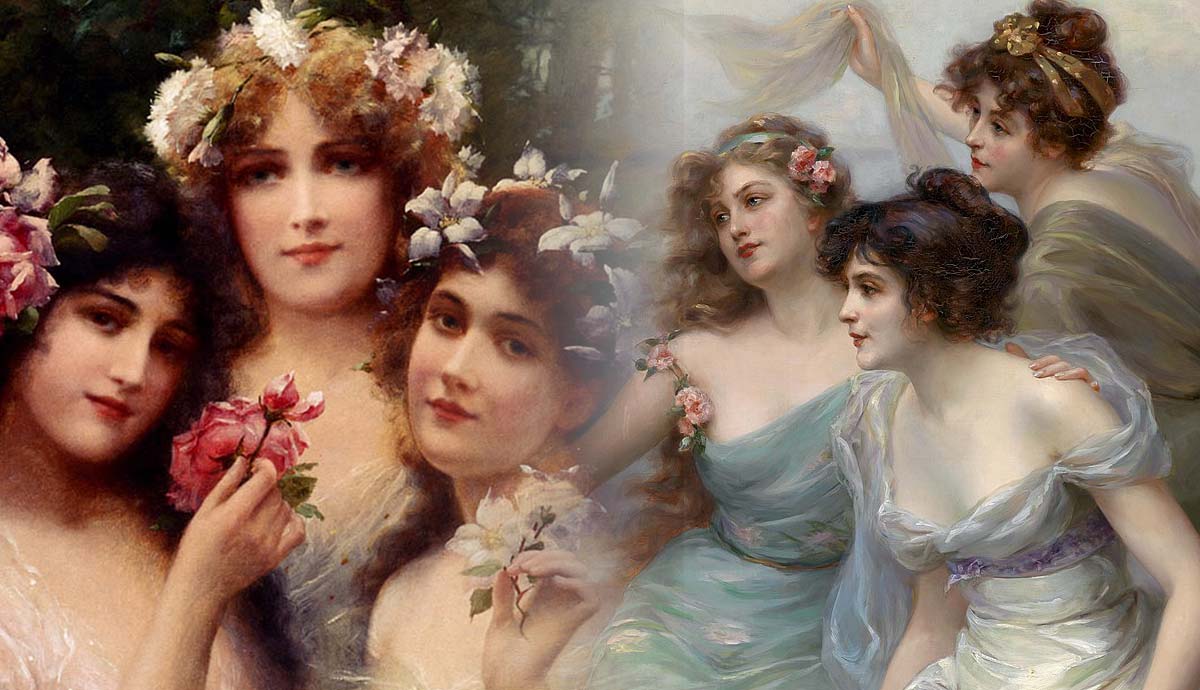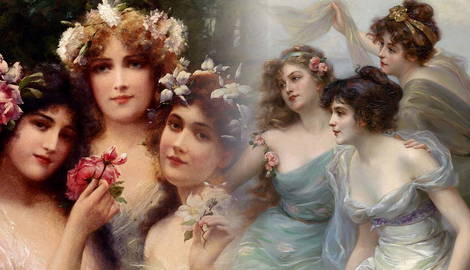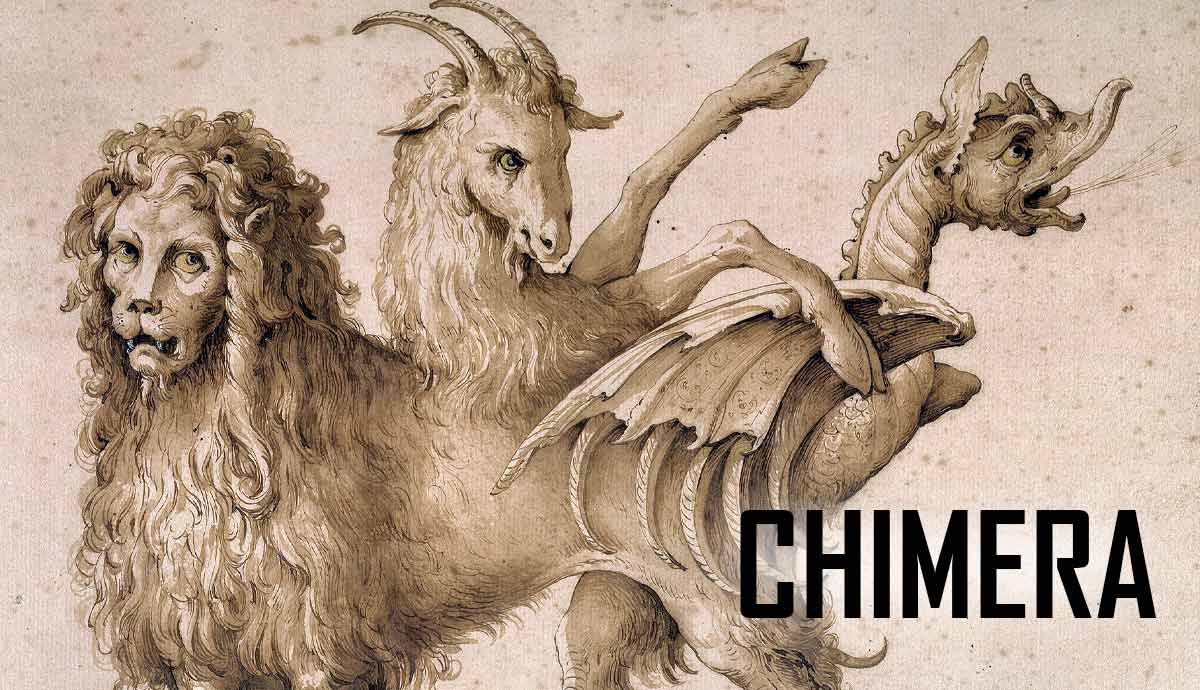
The Charites, also known as the three Graces, were a group of beautiful goddesses who embodied charm, grace, beauty, and joy. They presided over festival celebrations and were attendants to the goddess of love, Aphrodite. Initially, there were three Charites, but additional younger Charites were included over time, representing other aspects of celebration, grace, and abundance. While each Charis had power over a specific domain, they were all invoked to assist and guide individuals during various social gatherings. Read on to learn more about Greek mythology’s charming and graceful Charites.
The Origins of the Graces

Like many mythological figures, the Charites, known as the Gratiae (Graces) in Roman mythology, have a variety of origin stories. The most common version of their origins comes from Hesiod’s Theogony. According to Hesiod, the Charites are described as the daughters of Zeus and the Oceanid nymph Eurynome, the goddess of water meadows and pasturelands. Some, like the geographer Pausanias, suggested that the Charites were daughters of the sun god Helios and Aegle, the most beautiful Naiad nymph. According to the Orphic Hymns, the Charites were the daughters of Zeus and Eunomia, one of the Horae, a goddess associated with good order and lawful conduct.
In the Dionysiaca by Nonnus, the poet describes Dionysus as the father of the Charites. Throughout the poem, he presents several possible mothers for the Charites, such as Aphrodite and a woman named Coronis, who may have been a Maenad. The Charites were often said to have been nursed by Hera and were usually identified as her daughters, either by Zeus or another figure.
What Was the Function of the Charites?

The Charites, who personified grace and beauty, were not just divine figures but played a crucial role in ancient Greek society. Each member presided over different abstract aspects of grace and beauty, such as joy, abundance, celebration, and fertility. In Olympian Ode 14, Pindar praised the Charites for granting the gift of mortal joy and every sweet thing from wisdom, beauty, and glory that makes one’s soul richer. Their main role was to enhance social interactions by adding grace, beauty, and compassion while fostering joy, goodwill, and social harmony among attendees during gatherings.
The Charites also served the gods during various celebrations on Olympus, using their gifts of grace and beauty to enhance conversation and foster merriment among the Olympians. They often assisted Hermes, the god of speech, and Peitho, the personification of persuasion, in bringing grace and eloquence to social discourse. While artists and poets called upon the Muses for inspiration, people sought the Charites’ assistance to enhance their speech and social graces before attending gatherings, ranging from festive celebrations to significant political discussions that could impact society.

The Charites were frequently associated with other groups of female deities, such as the Muses, goddesses of inspiration, and the Horae, the goddesses of the seasons and the natural portions of time. As patrons of celebration, the Charites had strong connections to music, singing, and dance, linking them to the Muses. Their associations with fertility, growth, and abundance tied them to the Horae.
Many of the Younger Charites were also considered members of the Horae. These three groups of goddesses were often depicted dancing together while attending to Apollo, the god of music. In the Homeric Hymn to Pythian Apollo, the Charites, Muses, and Horae are shown dancing together to celebrate the birth of the divine twins. Likewise, in the Homeric Hymn to Artemis, the Muses and the Charites are described as dancing in the house of Apollo.
The Charites were closely associated with Aphrodite, the goddess of love, and frequently appeared alongside her in myths. In one hymn dedicated to Aphrodite, the Charites helped bathe and adorn her with beautiful decorations before she seduced Anchises, the father of the Roman hero Aeneas. They also served Aphrodite at Peleus and Thetis’s wedding and performed during the celebration. In the Odyssey, the Graces gathered once more to adorn their mistress and console her after she fled to her home in Paphos, Cyprus, following the revelation of her affair with Ares by Hephaestus.
Members of the Charites

Hesiod’s Theogony depicts the Charites as three beautiful, youthful, and radiant sisters: Aglaea, Euphrosyne, and Thalia. This portrayal became the standard in Greek mythology. However, ancient sources mention more than three goddesses as members of the Charites, leading to two distinct groups: the Elder Charites, which include the original three described by Hesiod, and the Younger Charites, which consist of a broader list of members. According to Hesiod, the Charites reside on Mount Olympus alongside Himerus, the personification of Desire.
Depictions of the three Charites often showed one with a rose, another with a dice, and the third with a myrtle flower. The rose and myrtle flowers symbolize the Charites’ strong connection to Aphrodite, to whom these flowers were sacred, representing love and beauty. In his book Description of Greece, Pausanias mentions that the Charites’ association with dice symbolizes their link to playfulness and youth, which remain unaffected by the cynicism of old age.
Hesiod’s poetry gained significant popularity, contributing to his depictions and interpretations of events becoming widely recognized among many ancient Greeks. However, despite the acclaim of poets like Hesiod and Homer, Greek mythology lacked a definitive canon. The names of various mythological figures, their forms of worship, and the stories surrounding them varied across different periods and regions in the ancient Greek-speaking world. This diversity may have contributed to the distinction between the Elder and Younger Charites.
The Elder Charites

The Elder Charites, first described in Hesiod’s Theogony, are Aglaea, Euphrosyne, and Thalia. Each Charite’s name reflects her specific powers and domains.
Aglaea, also known as Charis (the singular form of Charites) and Cale (Beauty), is the youngest of the Elder Charites. Her name means radiance, splendor, beauty, and adornment, which reflects her role as the goddess of beauty, splendor, and glory. She personifies the radiant glow of good health and beauty.
Aglaea was married to Hephaestus, the god of the forge and fire. While Hesiod and other writers described Aglaea as Hephaestus’s second wife, Homer referred to her as Charis. Hephaestus is usually depicted as married to Aphrodite, but many myths tell of their divorce after Aphrodite’s affair with Ares. Hephaestus exposed this betrayal to the other Olympians when he caught the two lovers entangled in a net, as recounted in the Odyssey. Aglaea and Hephaestus had four daughters who all became part of the Younger Charites: Eucleia (Good Reputation), Eupheme (Fame), Euthenia (Wealth), and Philophrosyne (Friendliness).

The marriage of Hephaestus and Aglaea was a wonderful union. As the goddess of beauty and splendor, Aglaea embodied the artistic adornment and beauty of crafted objects, enhancing her husband’s craftsmanship with unmatched elegance. Furthermore, the often gruff and isolated god of the forge benefitted from Aglaea’s grace and beauty in social interactions, as depicted in Homer’s Iliad. In Book 18 of the Iliad, Thetis, the mother of Achilles, visits Hephaestus to request a set of armor for her son following the death of Patroclus. Upon her arrival, she is welcomed and entertained by Aglaea, whom Homer describes as shining among the divinities, while they wait for Hephaestus to arrive.

Aphrodite and the prophet Teiresias are involved in a lesser-known story where Aglaea appears under the name Cale. According to the myth, Aphrodite and the Charites—Pasithea, Cale, and Euphrosyne—argue over who is the most beautiful among them. The goddesses asked Tiresias to judge their contest. Tiresias chose Cale, the goddess of beauty, as the winner. Aphrodite was angered by Teiresias’s judgment and punished him by transforming him into an older woman. In gratitude, Cale gifted Tiresias beautiful hair and took him to Crete.
Euphrosyne was the goddess of cheer, joy, and mirth, as reflected in her name, which signifies joy, cheerfulness, or mirth. Euphrosyne embodied the spirit of good cheer and joy, representing the euphoric happiness of living a fulfilling life.
The last of the Elder Charites is the lovely Thalia, the goddess of festivity and abundant banquets. Her name signifies abundance and good cheer. When used in the context of banquets, her name also conveys a sense of richness, luxury, and plentifulness. Thalia is believed to bring and sustain laughter and joy for all celebrations as the goddess of festivity.
The Younger Charites

Many writers regarded the Younger Charites as goddesses who held roles similar to those of the three Elder sisters. They were worshiped on a smaller scale in specific regions or else incorporated into narratives many years or centuries after Hesiod’s original account.
In Sparta, there were only two Charites: Cleta, who represented Renown, and Phaenna, who symbolized Brightness. Cleta embodied fame and glory and was called upon by those seeking success in personal endeavors. Shining Phaenna was closely associated with the light of the sun and moon, representing brightness.
In Athens, the primary Charites were Auxo, who represented growth and increase, and Hegemone, who represented leadership. Some accounts refer to a third Athenian Charis named Damia (the Earth Mother), Thallo (Blossoming), or Carpo (Fruit). Hegemone, the eldest of the Athenian Graces, was a goddess associated with blooming plants and was invoked to guide those seeking leadership. Thallo, Carpo, Damia, and Auxo (or Auxesia) are all associated with nature and the changing seasons. They are considered part of the Horae, the goddesses representing the seasons and the natural order. This illustrates the strong connection between these two groups of deities.

Hephaestus and Aglaea had four daughters who joined the Younger Charites. Eucleia represented glory and good repute, Eupheme embodied praise, acclamation, and shouts of triumph, Euthenia personified prosperity and abundance, and Philophrosyne presided over friendliness and welcome. Peitho, the personification of persuasion, was sometimes considered one of the Charites. Peitho’s close connection to the Charites is evident in their mutual influence over social discourse, and their collaborative relationship dates back to Hesiod’s story of the creation of the first woman, Pandora. In the poem, the Charites and Peitho decorate Pandora with golden necklaces and a crown of beautiful flowers.
Many of the Younger Charites are known mainly for their connection to Aphrodite through references to her or portrayals alongside her in art. For example, Antheia (Flower or Blossom) was the goddess of flowers and flowery wreaths worn during festivals and celebrations. Eudaemonia (Happiness), on the other hand, was the goddess of happiness, prosperity, and opulence. Other Charites close to Aphrodite were Pandaisia (Banquet), the goddess of rich banquets; Paidia (Amusement), the goddess of play and amusement; and Pannychis (Night Festivities), the goddess of night festivals and parties.

While the Charites are mostly mentioned attending other deities, the Chairs Pasithea plays a small role in the Iliad. Pasithea, whose name means relaxation, was the goddess of rest, relaxation, and hallucinogenic drugs. She embodied all forms of rest, including the relaxation and ecstasy experienced during trances and altered states of consciousness.
In Book 14 of the Iliad, Hera sought to assist the Greeks in gaining the upper hand against the Trojans. Zeus had forbidden the gods from further interfering in the Trojan war. Therefore, Hera planned to distract Zeus by seducing him and allowing Hypnos, the god of sleep, to cast a deep magical slumber over Zeus. Initially hesitant to oppose Zeus, Hypnos is eventually convinced by Hera, who promises him the hand of her daughter, the Younger Charis Pasithea, in marriage. Sleep and relaxation have always been closely linked. Since Hypnos had long been in love with Pasithea, he agreed to Hera’s deal and put Zeus to sleep.
Worship of the Charites

Worship of the Charites was widespread throughout ancient Greece, with particular significance in Boeotia. In his writings, Pausanias notes that King Eteocles of Orchomenus in Boeotia was the first to recognize the number three as significant to the Charites. Eteocles was the first to honor the Charites with sacrifices and offerings, hoping to receive their blessings. He constructed the first temple dedicated to the three Charites in Orchomenus. The local river Cephissus and the Akidalia spring were regarded as sacred to them.
According to some accounts, Eteocles began worshiping the Charites after his three daughters tragically fell into a well while singing and dancing in their honor. After their deaths, Gaia, the personification of Earth, took pity on the girls and transformed them into cypress trees.

The Charites’ worship in Orchomenus dates back to prehistoric times when they were worshiped as a triad of three local goddesses. They were revered as three meteorite stones in their temple. The Boeotians celebrated a local festival called the Charitesia in honor of the Charites. This festival featured various celebrations, including music, singing, and games. The highlight of the event was a competitive dance that lasted all night. Dancers who managed to endure until sunrise were rewarded with cake as a tribute to their dedication to the Charites.

Although their temple in Orchomenos was the first and most significant, the Charites also had temples in Hermione (Ermioni), Elis, and Sparta. King Lacedaemon, the son of Taygete, established the worship of two Spartan Charites. He built a temple in their honor near the Tiasa River in Amyclae, Laconia, naming them Cleta and Phaenna.
The worship of the Athenian Charites differed in some aspects. The three Charites—Auxo, Hegemone, and either Thallo, Carpo, or Damia—had their statues placed at the entrances of the Acropolis next to Hermes. In Athens, the Charites were also associated with a mystery cult, where initiates strictly guarded the practices and secrets of the cult. Young men in Athens prepared for military training by swearing the Ephebic oath, a vow to defend their city and obey its authority, before the shrines of the Charities, Auxo, and Hegemone.
In Messene, the Charites were worshiped alongside the Erinyes or Furies. At Olympia, they shared an altar with Dionysus. Later, the Charites were also venerated alongside Aphrodite and Apollo, particularly at the temple of Apollo on Delos.
Scholars believe that the cult of the Charites is very ancient. Initially, it focused on nature and fertility and was closely associated with rivers and springs, similar to nymphs. The Charites may have originated from Chthonic fertility deities, as early ceremonies did not include wreaths or music. While this type of solemn worship may seem contrary to the festive and joyful image of the Charites often discussed, many scholars suggest that evidence supporting this connection can be found in myth.

On the island of Paros, part of the Cycladic Islands, the Charites were worshiped without music or garlands. According to the myth, this solemn devotion is said to have begun when King Minos learned of the tragic news regarding his son Androgeus’s death in Athens while making sacrifices to the Charites on Paros. On hearing the news, Minos halted the music and removed his garland of flowers in sorrow. Subsequently, ritual law declared that the worship of the Charites would continue without music or garlands. The Cycladic Islands were among the earliest centers of worship for the Charites, and their unique form of prayer may reflect a vestigial reminder of the Charites’ Chthonic origins as goddesses of fertility and nature.
Throughout the centuries, these Chthonic goddesses of nature and fertility evolved into revered symbols of grace and beauty, inspiring those who seek connection and celebration among one another.










